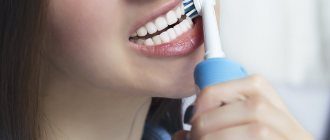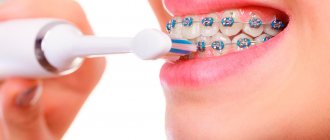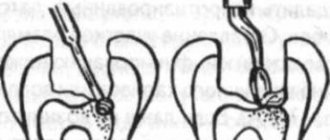Fecal coliform bacteria remain in the bathroom and are scattered throughout the room after the toilet user flushes; they can be a source of illness. You can get rid of the threat only with constant cleaning using antiseptics, but even this does not provide one hundred percent protection: particles can remain on door handles, combs and even toothbrushes.
In addition, devices for cleaning the mouth are already a breeding ground for pathogenic bacteria that remain after contact with the mucous membrane - in the future they can also cause infection. This is why it is so important to take care of their disinfection - we tell you how to approach the matter correctly.
Wash your hands before and after brushing your teeth
Bacteria and viruses are mainly transmitted through the palms - throughout the day they come into contact with many surfaces that are not always sterilely clean.
To stay safe during and after brushing your mouth, you should rinse your hands with soap and water for 20 seconds to remove any particles that might be left on the brush handle. After the procedure, you should also wash your palms to be on the safe side. In an interview with Insider, William Martin, president of the Maryland Dental Association, said that hand rinsing should, in principle, be a basic activity of every person - it will help reduce the risk of contracting viruses and infections, as well as minimize contamination of surfaces that a person touches.
How often should I sterilize?
Experts are divided on this issue.
For your information! Some people believe that disinfection needs to be done every week.
Others say the following. If you store your personal hygiene item correctly, you should disinfect it no more than once a month.
This can be done as long as you rinse the item with hot water after each cleaning.
After all, this procedure helps remove most possibly dangerous microbes.
Therefore, the choice remains personally for each person.
Learn how to properly store your toothbrush
The American Dental Association says it should be rinsed thoroughly under running water to remove any food, toothpaste, or tartar. After this, you should leave the brush to air dry in a vertical position - most bacteria die in an aerobic (oxygen) environment.
It is important to store the brush not in a case or small container, but in a spacious place, for example, a cabinet next to a mirror: the fact is that pathogenic particles may remain on the boxes for the device. Also, the brush should be left as far as possible from the toilet and be sure to close the lid before flushing it. You should also avoid leaving multiple brushes nearby, as germs can spread when they come into contact.
When does a brush become dangerous?
American scientists have found that on average, about 100 million microorganisms live on a toothbrush that is stored open. Among them are staphylococcus and other bacteria that can lead to infectious diseases.
After brushing their teeth, the average user simply rinses the brush with tap water. But such cleaning is not effective. At best, water only washes away food debris and surface contaminants, but is powerless against microbes. If your toothbrush is left untreated, bacteria will accumulate on it, increasing the risk of tooth decay, canker sores, bad breath and other dental problems.
Disinfect the brush
If you want to take extra precautions, or if you dropped the device on the floor, you can use hydrogen peroxide or mouthwash.
The first solution is a good antiseptic that destroys harmful particles picked up by the brush from the ground. The second contains alcohol, menthol and eucalyptol, which also help get rid of bacteria. To do this, rinse the bristles under running water, pour a little antiseptic into a glass - enough to cover the brush head, and soak the device for 10-15 minutes. Afterwards, rinse it again and leave it to dry in the open air.
Read on topic:Why and how to cleanse makeup products
Electric brush care
In general, you need to care for an electric toothbrush in the same way as a regular one. The processing rules are not too different. The pocket with batteries and microcircuit is reliably protected from moisture, so the device can be washed without fear.
However, there are several important nuances that need to be taken into account when caring for an electric brush:
- The bristle head wears out within 3 months and must be replaced.
- Discharged batteries should never be left in the device. They may start to leak. Then not only will the brush be damaged, but the acid may get into your mouth and cause poisoning.
- After use, the electric brush should be rinsed with warm water and dried.
When trying to disinfect the device, it is important not to overdo it. Boiling may cause the product to melt. According to GOST, an indicator of 1000 CFU/cm3 of microorganisms on bristles is the norm and, in the absence of diseases of the immune system, cannot lead to infection.
Every day, billions of bacteria come into contact with your toothbrush from your mouth. Among them are streptococci, staphylococci, E. coli, porphyromonas gingivalis, herpes and hepatitis viruses A, B, C, candida albicans, coliform and many others. Improper care can lead to frequent illnesses. It is important to thoroughly wash and dry the bristles, choose a suitable place to store brushes, and observe personal hygiene rules. Every 3 months the device must be replaced.
Use ultraviolet light
According to a study published in the American Journal of Dentistry back in 2008, UV light kills bacteria and some viruses by disrupting their molecular bonds. It also found that light was slightly less effective than alcohol or peroxide, but if you have an ultraviolet lamp on hand, this is a good way to use it.
Leave the brush next to it for a few minutes, then air it out in the open air. We do not recommend using a dishwasher or microwave as an alternative - the high temperature inside the equipment can damage the brush or even melt it.
How to properly brush children's teeth?
A child can be introduced to an electric toothbrush from the age of 3 years. But up to 7, you should guide the brush and not let go of it while brushing. During this period, it is important to teach the child to spit the toothpaste and rinse his mouth.
The technique of brushing teeth in adults and children is no different - the only difference is that parents help children brush their teeth. Sit in a way that is comfortable for both of you: sit the child on your lap or stand behind him in front of the mirror. If your brush does not have a built-in two-minute timer, use a special application that will motivate and captivate the child (for example, some applications gradually open a picture of cartoon characters while brushing teeth).
Keep your brush safe while traveling
To ensure that it does not become a breeding ground for bacteria, get a separate case or cosmetic bag where only the cleaning device will be stored.
Upon arrival, unpack your things, leaving the brush in the bathroom and rinsing it first. Before you leave, rinse it, dry it thoroughly, disinfect the storage case and place the brush in it.
Storage rules
Germs simply love dark, damp, cool places, like the bathroom. In such conditions, they remain viable for a long time and reproduce. For example, on a poorly washed wet brush. The correct way to store it is as follows:
- Use a special vertical cup with a separate hole for each toothbrush. It is important to avoid cross-contamination from other surfaces, including brushes from other family members.
- Take care of ventilation. The washed bristles should dry completely. Do not place the brush directly into the container. By and large, it is intended only for transportation or storage on the road.
- For a shared bathroom, choose a storage location away from the toilet. When flushed, harmful particles enter the air and then settle on nearby surfaces within a radius of 1.8 m. If it is impossible to move the brush over such a distance, you should purchase a protective cap with ventilation holes.
- Keep the brush storage container clean. Wash the cup or holder at least once a week with soap and hot water. To remove stains, use baking soda and a sponge that has not been used on the sink or other surfaces.
Flossing
A toothbrush does not clean dirt between teeth well enough, so home hygiene should include the use of dental floss. Floss is a thin synthetic thread that is used after meals. The thread can be flat or round, flavored or coated with fluorine. If you have dentures or crowns on implants, dentists advise using superflosses, which differ from regular threads in having a wider end.
Hygiene using floss is performed as follows:
- For one cleaning, cut a piece of thread up to 50 cm long.
- Smoothly place the floss between the two teeth.
- Lower the thread to the surface of the gum.
- Carefully and without sudden movements they lift it back up.
After cleaning one interdental space, move on to another and repeat the procedure. A clean section of floss should be used for each crevice. If the performed manipulations do not remove plaque between the teeth well, it is advisable to resort to professional hygiene.
How to choose toothpaste?
Not all people attach importance to the right choice of toothpaste. Meanwhile, the quality of cleaning and the results of dental care largely depend on it. Dentists recommend choosing products containing calcium, fluoride, and natural herbal ingredients. If necessary, medicinal pastes (for example, with chlorhexidine) can be used, but the period of their use should not exceed 2-3 weeks.
If your teeth are sensitive, you should be careful when using products with a whitening effect. If such pastes are abused, there is a high probability of the formation of wedge-shaped defects - small gaps that appear on the outer surface of the front teeth. Over time, they can lead to exposure of the neck of the tooth and destruction of the dental crown.
We know how to take care of your teeth
Duration of operation
Each dentist may give different advice regarding the duration of use of one device. The best option is one month, but up to 100 days is acceptable. You can purchase special brushes that have wear indicators.
You need to buy a new item in the following cases:
- service life exceeded 3 months;
- after suffering from any diseases of the gums, teeth and oral cavity, including runny nose and common colds;
- the bristles began to “look in different directions”, some of its elements became bent and worn out - in this case, brushing your teeth will be less effective.
The note. Before the first use, simply rinse the purchased device in running water, after soaping the bristles.
Irrigator for dental hygiene
An irrigator is considered an indispensable device for pronounced interdental spaces, wearing braces or the presence of periodontitis. The principle of its operation is based on the supply of a water jet under pressure, which removes food debris between the teeth. Using an irrigator, you can clean bacterial plaque, remove dirt, and massage your gums. It is permissible to use not only water as a washing liquid, but also special agents that have a therapeutic or preventive effect.
The purpose of using the device can be:
- prevention of caries formation due to high-quality cleaning of interdental spaces;
- prevention of gum disease (the massage effect improves blood flow in soft tissues, eliminates bleeding, accelerates gum regeneration when damaged);
- maintaining cleanliness of dental structures.
The device is used according to the manufacturer's instructions. Almost all models have several cleaning modes, which are selected according to the user’s needs. Thus, the mono-jet mode provides a continuous flow of jets, the pulsating mode supplies jets at short intervals (pulsation), and the micro-bubble mode creates millions of microscopic bubbles that effectively cleanse microbial plaque.
What happens if you don't do this?
If you do not disinfect on time, you can complicate your life. After all, the human oral cavity is inhabited by a variety of microbes.
Note! While everyone knows that it is necessary to brush your teeth every day and rinse your mouth with a special solution, many people do not think about the fact that they take care of their hygiene items.
In order to prevent the spread of harmful bacteria, disinfection measures must be taken.
If this is not done,
bacteria will multiply and the likelihood of various diseases will increase.











